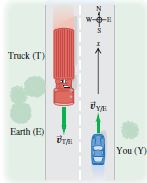Relative Velocity In One Dimension With Examples

Relative velocity is the velocity of an object measured relative to another. It can also be seen as the vector differences between the velocities of the objects.
In fact, motion is relative. The position and velocity of an object is always described with reference to a particular coordinate system. When we speak of the velocity of a moving car, we usually mean its velocity with respect to an observer who is stationary on the earth.
If two objects are travelling directly towards each other with speed v, as measured by someone stationary on the ground, then each object sees the other one approaching with a speed of 2v.
Thus, if objects are traveling in opposite directions we add their speeds to find the R.V i.e. R.V =VA – (-VB)
If the objects are moving in the same direction then we subtract their speeds to find the relative speed i.e. R.V = VA + (-VB)
Read: Short note on kinematics (one dimensional motion and projectile)
Examples And Solutions
Example 1
If a car A is traveling at 50km/hr is moving in the same direction as another car B traveling at 60km/hr. Find the relative velocity of B to A.
R.V of B to A = 60 – 50 = 10km/hr
If, however, the cars are travelling in opposite directions, the R.V B to A = 60 – (-50) = 110km/hr
Ex 2
You drive north on a straight two-lane road at a constant 80km/hr. A truck in the other lane approaches you at a constant 100km/hr. Find (a) the truck’s velocity relative to you and (b) your velocity relative to the truck.

- R.V = -100 + (-80) = -180 km/hr . The velocity
of the truck is negative because it is travelling in the opposite direction to
you in the other lane i.e. the truck is moving towards the south. - R.V = 80 – (-100) = 180km/hr
